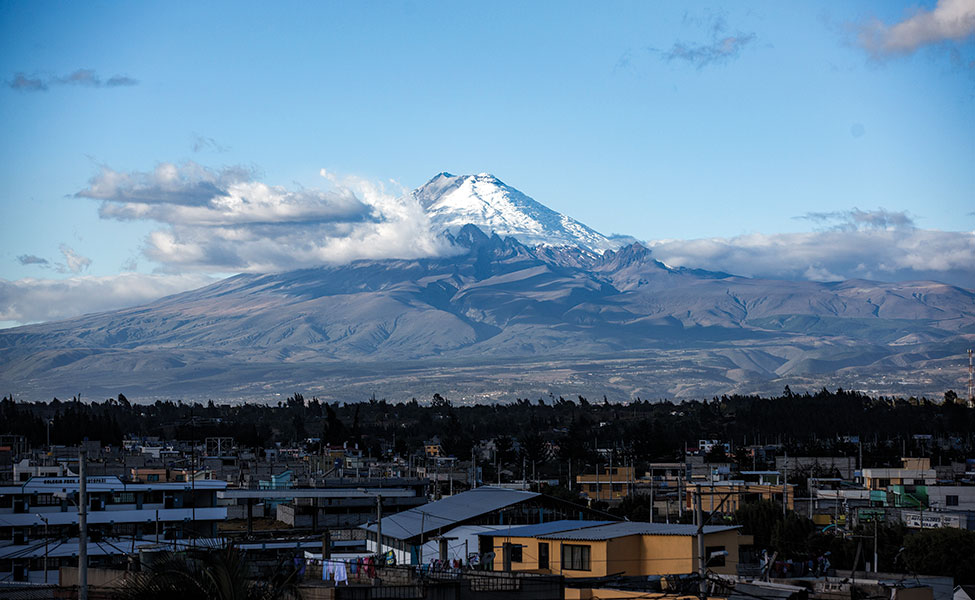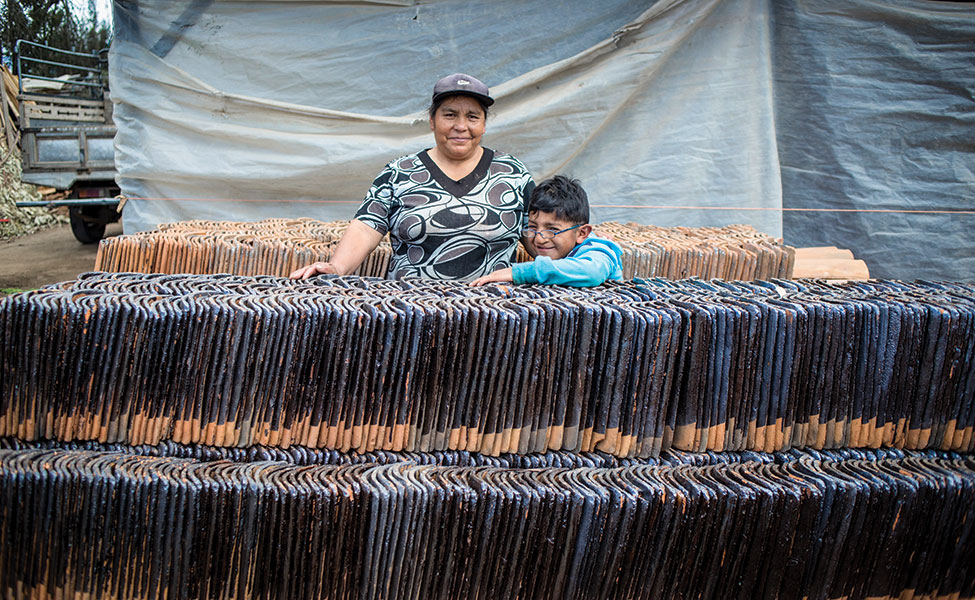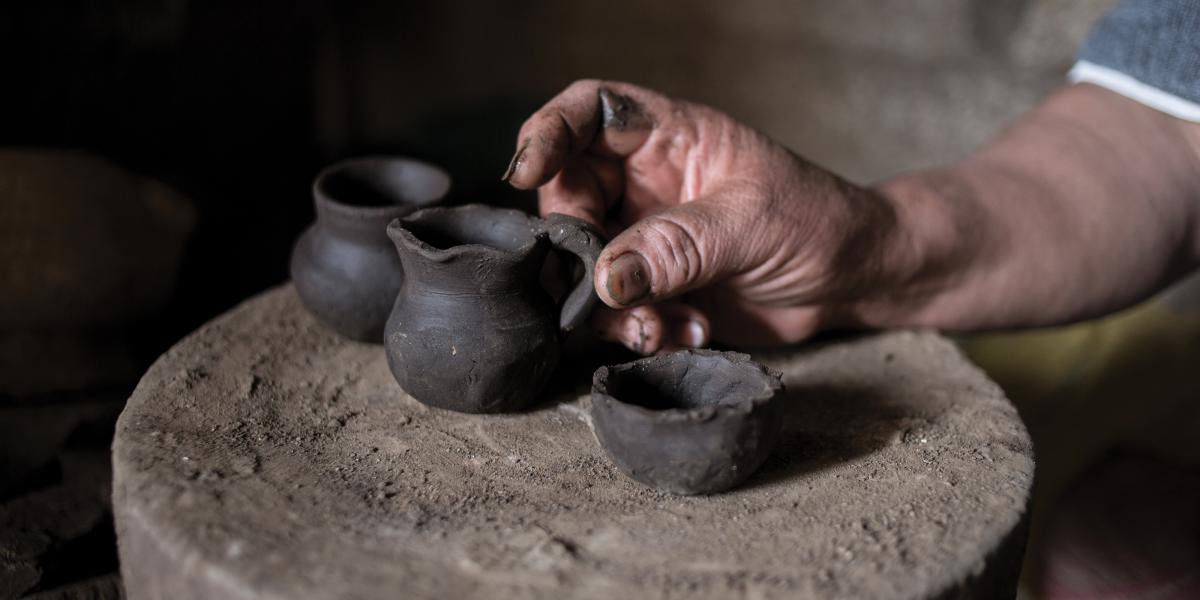Lead's Desperate Artisans
An impoverished Ecuadorian community thrived in the 1990s making roof tiles—but their children paid a horrific price.
The clattering bus from Pujilí to Latacunga stops at a corner decorated with towering statues of colorful, rosy-cheeked potters working on their crafts. A sign reads: Bienvenidos a la Parroquia La Victoria, “Welcome to the parish of La Victoria.” From this corner, I hop in the back of a pick-up truck with five or six locals. The floor of the bed is wooden, and the seats are boards with disintegrating cushions.
The truck stops at a central plaza with yellow tiles and pink concrete walls, flowering trees and a Catholic church. From here I walk about a mile—past rows of aloe vera, past children with kites, past houses and families I have come to know.
La Victoria, Ecuador, is nestled in the Andes, 125 kilometers south of Quito. During the 1990s, aspiring craftspeople came to La Victoria because the village had a profitable ceramic tile manufacturing industry. Artisans in La Victoria made roof tiles by the thousands, and they exported them across the country. They glazed the tiles for strength, impermeability, and aesthetics.
The main ingredient of the tile glaze was lead.
Lead has been used in ceramic glazes for thousands of years for its beautiful and strong finish—but more importantly—because it enables the glaze to melt at a lower temperature, facilitating the use of backyard, low-fire kilns. In La Victoria, to get the lead for these glazes, artisans turned to the lead plates from car batteries, manually removing them and melting them down in their kilns. This process aerosolized the lead, enabling it to be inhaled by people and distributed across the environment, widely contaminating soil, foods, objects and homes.
This is a story about a rural artisan community afflicted by tragedy, about children whose health and lives were unwittingly sacrificed through desperation and a poverty-driven and unfortunately toxic ingenuity. This is also a story about public health in a developing country, where good intentions, imperfect interventions, a lack of regulatory oversight and a society submerged in hardship have come together to yield mixed results.
Past the aloe vera, scattered homes and children flying kites, around a barren bend and up a hill crowded with small houses lies a simple homestead with indoor and outdoor living spaces, white siding folding a bit with age and myriad cushions, pails, clothing and other objects collected over time.
This is the home of Juan Molina.
Molina, 66, is a soft-spoken and thoughtful man who moved to the village of La Victoria in the early 1990s to start a business making ceramic roof tiles by hand. He wears a baseball cap over his round face and tired eyes. His brow is furrowed.
“I had eight children, but the first two of them died” in 1997 and 1998, Molina tells me. His first child was Wilmer, and his next was a girl named Magdalena. “Both of them died of convulsions,” he explains. “The authorities said it was from lead contamination. They wanted to do a scientific analysis, but they couldn’t because it was costly. They supposed it was lead toxicity, and that could be possible.”
The Molinas’ next child, Margod, is now 33. She is small and frail, and she shies away from attention. Margod is mentally disabled. She can speak, but she was never able to learn or attend school. According to her father, Margod has begun helping with chores around the house little by little over the years, but she is hot-headed and can be aggressive to her family.
“We used to live right next to the oven, right next to the glazing process. But when the children were diagnosed with their problems, we took the oven further away from the house and then we abandoned it,” Molina says.
Molina’s abandoned kiln now stands about 20 yards behind the house. The kiln, like most of those in the backyards of local artisans, is made of bricks and cemented with mud. The walls around it are formed from rows of roof tiles, held in place by mortar.
Tile-making used to be a good business in La Victoria. “We had resources and we had good money then, but regrettably it didn’t serve for anything long-term,” Molina laments.
Molina stopped producing roof tiles when his family got sick. Instead, the family now decorates pre-made ceramic animals and vases with paints and metallic enamels. When I ask him what he thinks of the job, Molina tells me, “Enjoy the work or not enjoy the work—we have to do this because there is nothing else, of any form. We have to do this.”

NO SAFE LEVELS
Juan Molina’s concerns about lead exposure and its pernicious effects are more than justified. According to the WHO, lead is a cumulative poison, distributed to the brain, liver, kidneys and bones, where it can affect multiple body systems.
People can ingest lead that has contaminated the soil and dusted fruits and vegetables, children’s toys and living spaces. Lead can be released into a mother’s blood stream from her bones during pregnancy, and infants can be exposed to lead through contaminated breast milk.
In children, lead is often associated with neurodevelopmental disorders, motor or cognitive impairment, learning disabilities, behavioral problems, coma, convulsions or death. In adults, chronic lead exposure can harm the neurological system, the kidneys and the circulatory system. It also can cause high blood pressure.
Young children are particularly vulnerable, the WHO says, because they can absorb four to five times as much lead through respiratory and gastrointestinal routes as adults, and their innate hand-to-mouth behavior makes exposure more likely. Lead has a profound impact on the developing nervous system, so children exposed at an early age are more likely to develop impairments.
No safe blood level has been determined for children. Alan Counter, MD, of Harvard University, and Ferdinand Ortega, MD, of Universidad San Francisco de Quito, have studied lead exposures in La Victoria since 1997 and have observed cognitive impairment in children with blood lead levels as low as 10 micrograms per deciliter (µg/dL).
In 1998, around the time that Molina lost his first two children, Counter and Ortega reported an unusually high percentage of children in La Victoria with blood lead levels between 45–70 µg/dL. Some were even higher. The higher the blood lead level of the children they tested here, the lower the score for nonverbal intelligence they found. (The researchers declined to be interviewed for this article.)
Raul Harari, director of the IFA Corporation for Production, Labor, and Environmental Development in Quito, was part of another research team studying lead toxicity in La Victoria in the 1990s. “We found children not able to go to school, or remaining two to three years in the same grade level,” he says.
Soledad Suntasig, 40, has lived in La Victoria her whole life. She has seen the worst of the village’s lead toxicity, and she believes her own son Italo, 23, was affected. “Almost everyone was using lead. Just about 100 percent. Italo ate a piece of lead, just like it was bread or chocolate, when he was 9 or 10 months old,” Soledad remembers. “He looks healthy now, but I can say that something’s affected his nervous system. He understands everything, but to me, it’s apparent that he’s nervous and fearful. He is psychologically affected.”
In the 1990s, most villagers in La Victoria were unaware of the health problems associated with lead exposure. In response to their early studies, Counter and Ortega set up a training and prevention program for the community in 1997. Mediation of the problem focused on hand-washing, food-washing and wearing respiratory masks and gloves. Facemasks can still be seen hanging in most workshops. Gloves appear sporadically. Adults in the village believe these interventions have improved conditions. Phytoremediation, the use of plants to clean up contaminated soil and water, was recommended for La Victoria by Counter in 2000, but no reports of this cleanup effort have been made.
In 2003, the Ecuadorian government published a set of environmental requirements known as the Unified Text of the Second Legislation of the Ministry of the Environment (TULAS). The sixth TULAS volume contains the National List of Prohibited and Dangerous Chemical Products. It prohibits the use of lead in manufacturing, but enforcement has been weak.
Instead of applying strict legislative force, the municipal government of Pujilí, which oversees La Victoria, has been asking local political and artisan associations in La Victoria to regulate the community’s lead-using behaviors internally. “Enforcement of the rules is primarily social for us,” says Edgar Neto, director of Environmental Management in the Municipality of Pujilí, “but there can also be a $7,000 to $70,000 fine.”
Neto tells me that environmental health inspections should be done in La Victoria every three months, but there are no police to enforce the environmental laws. Although no one in La Victoria tells stories of fines levied for crimes against the environment, the social structure within the political and artisan associations here is strong, and much of the lead use among artisans has changed.

TWO VIEWS OF LA VICTORIA
“There are two ways to talk about La Victoria,” says Neto. “The ancestral, when life was totally concentrated in the elaboration of ceramics, which produced mental retardation and illnesses of other systems, and the new theme there: much recuperated.”
Indeed, the village may appear “recuperated” because the incidence of severe birth defects due to lead toxicity has markedly decreased, and today most patients with obvious disabilities are more than 20 years old.
Patricia Borga, MD, of the Subcentro de Salud (the local health clinic) in La Victoria, is among those who think that things have changed for the better. “Childhood lead toxicity is not the main problem we are seeing in our patients now,” she says, noting that the village currently has only one child with a clinically documented mental disability.
Although the current number of families using lead from car batteries is not officially documented, the Subcentro de Salud’s Angela Collaguaso, RN, says only about seven families are still openly using the lead from car batteries with their kilns. This represents about 10 percent of the families who were glazing with lead in the past.
“Obviously, there are still problems continuing,” Neto says. “It is very difficult because we have had this going on for so long. But the problem isn’t as profound as it used to be. The problem is very low in our children.”
While excessive exposure and acute lead toxicity may have abated, lead’s potential for health problems continues—in the form of chronic exposure.
The U.S. CDC’s “upper reference interval value” for lead, indicating the 97.5th percentile for children, is 5 µg/dL. This means that only the most abnormal 2.5% of children’s blood lead values lie above 5 µg/dL. The most recent average blood lead level for infants and young children in La Victoria, measured by Counter and Ortega in 2015, was to 29.4 µg/dL. Children with these blood lead levels are “likely to develop mild to severe neurodevelopmental disabilities,” according to Counter and Ortega.
Three years earlier, in 2012, Counter and Ortega reported that “a majority of adults continued to show evidence of prolonged lead exposure, with adverse effects on the hematological system.”
Chronic lead toxicity in adults can result in hypertension, chronic kidney disease and potentially subtle neurological signs such as dizziness, fatigue, lethargy, irritability, diminished cognitive performance or slowed reaction times.
To date, no efforts have been made to test for signs of chronic lead toxicity in adults or children in La Victoria—despite the fact that the Subcentro de Salud sees hypertension commonly in its adult patients.

THE LAST CHILD
From his position as director of environmental management in Pujilí, Edgar Neto appears eager to further improve the conditions for artisans and their families in La Victoria.
He is excited to tell me that the Ministry of Pujilí has a plan for better ceramic ovens. “We are trying to help—the artisans and also the environment. A Swiss company has proposed to build ovens here with better ventilation and complete combustion, which wouldn’t generate so much harmful smoke,” he says.
“The proposed project won’t fix it all, but it will hopefully minimize the environmental impacts,” says Neto. He adds, “The people need to get on board, too. This is a business proposal for the artisans, and if just one part of the process doesn’t work right, they won’t accept it.”
The new ovens would theoretically burn at a higher temperature, allowing artisans in La Victoria and other villages to use lead-free glazes. But Marco Rodrigo Mena, 44, a potter in El Tejar, says that one of these new ovens would cost over $25,000. Neto confirms that the new ovens are costly.
Such a price tag is way beyond what Hilda Maria Sontasig, 55, can afford. Sontasig has been producing lead-glazed roof tiles in La Victoria for 40 years. She is one of the artisans who continue to supplement frita (a factory-produced glaze, containing fused lead) with cheap lead from used automobile batteries.
“There is nothing else to use,” says Sontasig, a jovial woman, usually seen sporting an apron and a baseball cap. “I use the frita, plus something else to give color. Pilas [small appliance batteries] give black, copper wires from light fixtures make green, and lead from car batteries gives the shine. It’s not possible to make these colors with frita alone.”
“I only use old car batteries, of course. They’re very old, and they don’t serve for the cars anymore.”
Sontasig’s youngest daughter, Mayra, 29, has severe learning disabilities. “She knows how to write her name, but Mayra forgets everything,” Sontasig says.
Sontasig’s grandson, Éric Davíd Aguayo, moved in with Sontasig when he was 2. “Éric really likes playing around here and helping me with my work,” says Sontasig.
Éric was born with a cleft lip and suffers from hearing problems. “Éric is 7 years old, but he acts like 5. He started to be a bad student two years ago,” says his mother, Anita Romero. “He needs a lot of help with language, psychology, and occupational therapy.”
As of summer 2016, physician Patricia Borga only knows of one child in La Victoria who has a clinically documented mental disability.
That child is Éric Davíd Aguayo.
